TEXAS FIGHT
The History of the Longhorns’ Big 12 Era and Rise to the Top of the Conference in 2023

Vince Young, Ralph Barrera / Austin American-Statesman; Alabama game, Aaron E. Martinez / Austin American-Statesman; Steve Sarkisian, Aaron E. Martinez / Austin American-Statesman; Mack Brown, Rodolfo Gonzalez / Austin American-Statesman; Longhorns flag, Deborah Cannon / Austin American-Statesman.
Credits Writers
Sports Editors
John Bridges
David Humphrey
Jason Jarrett
Tim Lott
Richard Tijerina
Columnists
Kirk Bohls
Cedric Golden Writers
Ryan Autullo
Brian Davis
Danny Davis
Thomas Jones
Copyright © 2024 by Austin American-Statesman
All Rights Reserved • ISBN: 978-1-63846-081-7
No part of this book may be reproduced, stored in a retrieval system or transmitted in any form or by any means, electronic, mechanical, photocopying, recording or otherwise, without prior written permission of the copyright owner or the publisher.
Published by Pediment Publishing, a division of The Pediment Group, Inc. www.pediment.com • Printed in Canada.
This book is an unofficial account of Texas Longhorns football history from 1996 through 2023 and is not endorsed by the National Collegiate Athletic Association or the University of Texas.
Suzanne Halliburton
Joe Harrington
Kevin Lyttle
Randy Riggs
Kevin Robbins
Mark Rosner
Mark Wangrin
Photographers
Ralph Barrera
Ricardo B. Brazziell
Deborah Cannon
Mikala Compton
Sara Diggins
Brian K. Diggs
Rodolfo Gonzalez
Jay Janner
Taylor Johnson
Aaron E. Martinez
Nick Wagner
2 • TEXAS FIGHT
FRONT COVER CREDITS, CLOCKWISE FROM CENTER: Quinn Ewers, Aaron E. Martinez / Austin American-Statesman; Golden Hat, Ricardo B. Brazziell / Austin American-Statesman;
INTRODUCTION • 3 Table of Contents Introduction .............................................................................................................................................................................................................................................................................. 4 Texas’ Defining Faces ................................................................................................................................................................................................................................ 7 The 10 Biggest Games ..................................................................................................................................................................................................................... 18 The 10 Biggest Plays ............................................................................................................................................................................................................................ 46 The Mack Brown Era ................................................................................................................................................................................................................................ 67 The Charlie Strong Era 79 The Tom Herman Era 97 The Steve Sarkisian Era 121 Big 12 Championship Game 151 Epilogue 158
Texas left the Big 12 just as it entered the Big 12: as champions
KIRK BOHLS
The phone call to the Texas president’s office came more than 34 years ago in June of 1989.
The person on the other line was the Georgia president, and it was much, more more than a courtesy call.
Subsequent to the mysterious call that set up a hush-hush meeting, Georgia’s Chuck Knapp, a former assistant professor at Texas, held a frank conversation with Texas President Bill Cunningham at a law office in Washington, D.C., days later.
Out of the blue, Knapp offered a private invitation that he wanted the Texas president to consider.
Come join the Southeastern Conference.
The request came as a surprise, and an intrigued Cunningham said his school would seriously consider it, which Texas did. Shortly thereafter, Cunningham sat down back in Austin with Longhorns athletic director DeLoss Dodds and Texas administrators Shirley Bird Perry and Ed Sharpe to mull it over.
They did, but after much deliberation, Texas said no.
Instead, the Texas brain trust after much deliberation chose to pursue potential membership in the Pac-10 or Big Ten. Neither materialized although
Cunningham, who had served as president or chancellor for 17 years from 1985–2000, said the flirtation with the Pac-10 became very serious until Stanford ultimately blocked that league’s invitation.
As Cunningham wrote in his book, “The Texas Way: Money, Power, Politics and Ambition at the University,” “My feeling was that Stanford was afraid of having to compete against UT Austin.” He was probably accurate because Stanford has long been the preeminent leader in its across-the-board athletic department and its status in Olympic and non-revenue sports. The Palo Alto, Calif., school has reigned as the Director’s Cup ringleader, winning the mythical title as best athletic director for 26 consecutive years until Texas usurped its role in back-to-back years in 2021 and 2022.
That said, the wheels of expansion were set in motion by that single call from the SEC representative. That development triggered some exhaustive research by Texas and a series of events that ultimately led to the dissolution of the struggling Southwest Conference and the formation of a new blended conference with the Big Eight.
They decided to call it the Big 12.
The seeds for the newest Power Five conference had been originally planted in some serious conversations between Dodds and the late Donnie Duncan, the Oklahoma athletic director and former Sooners football assistant coach and a longtime great friend of the Longhorns boss.
At one time, seven of the nine members were competing under NCAA sanctions, none more severe than those handed to SMU in the form of the “death penalty.”
Dodds and Duncan put out feelers about a potential merger between the SWC and Big 8 and not long thereafter invited Kansas athletic director Bob Frederick into the mix because of the Jayhawks’ preeminent basketball program and Texas A&M’s John David Crow because of the Aggies’ stature.
“It started off just me and Donnie, and it kind of grew from there,” Dodds told the American-Statesman recently. “We talked about it for a long time and thought our conferences where they were geographically located, didn’t have a lot of population because television was becoming a bigger and bigger factor. So we thought the only way to do it was to
put the two conferences together.”
And that they did, but not in their entirety. Some didn’t make the cut.
Never mind that the misnomered Big 12 frequently deviated from that number over the 27-year history of the league. It went through several reincarnations — and incriminations, for that matter — with schools coming and going before it eventually played out the final academic year of 2023–24 with no fewer than 14 members as spread out as BYU in Utah to Central Florida.
But in the beginning, when the Big 12 was created, the four surviving members of the 82-year-old SWC — Texas, Texas A&M, Baylor and Texas Tech — would jettison the three private schools in the league at TCU, SMU and Rice and public school Houston in large part because of their declining attendance and lesser profiles. The four survivors joined forces with Oklahoma and its seven other partners of the Big Eight to create the Big 12.
It was clear to Dodds and Duncan the venerable SWC, founded in 1914, was taking on water and the Big Eight was looking for a lifeline as well.
“We were both in a weakened position,” Dodds said, “and we needed to fix it.”
4 • TEXAS FIGHT INTRODUCTION
Texas and its three hand-picked SWC partners had to first navigate through some conflicts in the Legislature and statewide pressure to keep the SWC intact. The presence of Gov. Ann Richards, a Baylor alumnus, Lt. Gov. Bob Bullock with degrees from Texas Tech and Baylor; State Rep. Rob Junnell, chairman of the House Appropriations Committee; and Rep. John Montford of Lubbock protected the interests of Baylor and Texas Tech.
“I wanted to go to the Big Ten,” Cunningham told the Statesman recently. “But we almost went to the Pac-12. Stanford voted against us, and the vote had to be unanimous. Stanford was worried about us being so good in academics and athletics, especially Olympic sports.”
So after years of hand wringing and speculation and friction between schools’ administrations and fan bases, the Big 12 took to the field. The rookie league debuted in September 1996.
Texas played its first league game in a deluge at home against Missouri, which ironically was the first with its hand up for realignment and petitioned the Big Ten to take it. That conference declined.
And the Big 12 took shape with its league home office in Dallas, much to the chagrin of the Big Eight members, and with SWC commissioner Steve Hatchell as the league’s new boss. Many weren’t happy about either.
But somehow the league muddled through for almost three decades until splintering with A&M and Missouri leaving for the SEC, Colorado heading to the Pac-12 and Nebraska aligning with the Big Ten.
Texas would win the Big 12 football crown in its initial year and AGAIN in its last season in 2023.
The perfect set of bookends.
In between, the conference would come to be dominated by the Oklahoma Sooners, who captured more than half of the football titles with 14. They, like Texas, would win a single national title and compete for several more.
The Longhorns would produce their second Heisman Trophy winner in Ricky Williams while the Sooners one-upped them with four of their own in quarterbacks Kyler Murray, Baker Mayfield, Sam Bradford and Jason White. The
had been so oppressive that the Longhorn band members wore khaki shorts.
Texas blasted Missouri 40-10 and for the first time introduced sophomore sensation Ricky Williams at tailback after he had played fullback as a freshman, and he didn’t disappoint with 112 yards and two touchdowns as a precursor to his Heisman-winning season two years later in 1998.
More than three months later on Dec. 7, Texas couldn’t have kicked off the league with more fanfare than that inaugural 1996
“Texas would win the Big 12 football crown in its initial year and AGAIN in its last season in 2023. The perfect set of bookends.”
KIRK BOHLS
Longhorns’ very first football game came on Aug. 31, 1996, a rain-soaked, lightning-powered show at Darrell K Royal Memorial Stadium against Missouri. The school had just renamed the facility built in 1924 after the legendary Darrell Royal and also unveiled a new grass field, a new scoreboard and a new Jumbotron screen that wowed the crowd of 70,613.
So torrential was the steady downpour that the game was stopped for 45 minutes, the first-ever weather-delayed contest at DKR. Beforehand, the heat and humidity
showdown with Nebraska for the first Big 12 title at St. Louis’ Trans World Dome.
On that December day, the stoic John Mackovic’s Longhorns Rolled Left on fourth-and-inches with one of the most famous gambles in program history of a school that has won the fourth-most games in college football.
Texas quarterback James Brown had been asked during the week preceding the game about the lopsided betting line that had made the Cornhuskers a three-touchdown favorite and said
calmly, “Maybe we’ll beat them by three touchdowns.”
Longhorn Nation was beside itself in joy over the 37-27 win, but couldn’t exhale until Brown’s’ fourth-down pass from Texas territory to tight end Derek Lewis that led to a stunning upset of a No. 3-ranked Cornhuskers team with strong designs on a third consecutive national championship.
“I still remember him looking up at himself on the video board,” Dodds said, “and going from carrying the ball with one hand to carrying it with two.”
The other two Longhorn Big 12 titles came in the first decade of the 2000s. In 2005 the incomparable Vince Young capped a perfect 13-0 season with a win for the ages over an undefeated, topranked USC team in the Rose Bowl in the best bowl game ever. Four years later in 2009 a neck and shoulder injury to quarterback Colt McCoy on the fifth offensive play of the game against Alabama sidelined him for the game and deprived Texas of a possible fifth national crown.
By the time the Big 12 championship signaled a glorious end to the football reign, Texas had already begun to make preparations for its new stomping grounds in the SEC.
The Big 12 was born out of necessity.
Texas and Texas A&M, driven by a desire for a stronger television deal and better stability and security as well as a partnership more in keeping with their own big profiles, looked for greener pastures.
Texas found those in the SEC and bid the Big 12 a (sort of) fond farewell in the only fitting way it could.
The Longhorns went out the exact same way they went in. As champions.
INTRODUCTION • 5
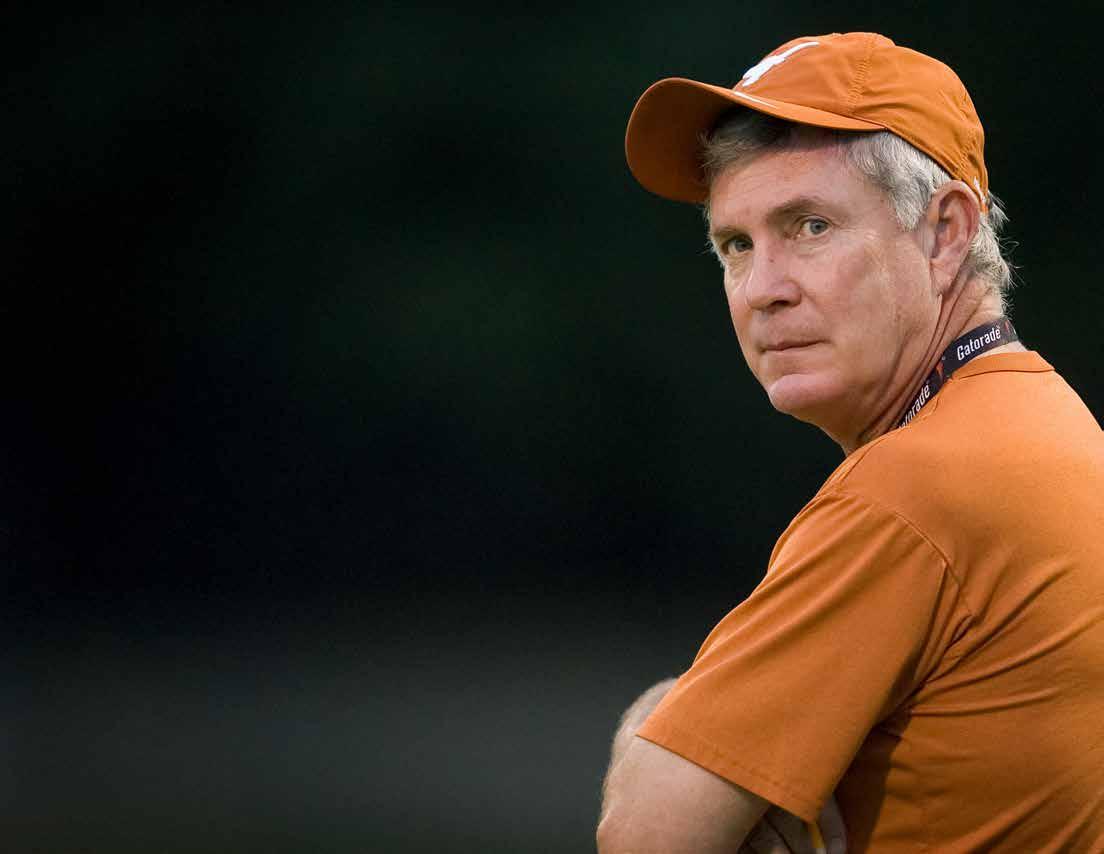

205 games later, a look back at the Mack Brown era
SUZANNE HALLIBURTON • DEC. 16, 2013
A look back at Mack Brown’s 16-year tenure as Texas’ head coach:
1998–2003: The building years 59-18, 3-3 in bowls
Brown’s first season could only be described as charmed.
There was a rough 1-2 start, including the loss of starting quarterback Richard Walton, in defeats at UCLA and Kansas State. Then Ricky Williams and Major Applewhite — a redshirt freshman quarterback — took over.
There were wins over Oklahoma and at Nebraska. Williams broke the NCAA career rushing record in a victory over Texas A&M on his way to the Heisman Trophy. Then came a New Year’s Day victory in the Cotton Bowl, followed weeks later by the signing of the nation’s No. 1 recruiting class.
But expectations truly weren’t met for several more years. The Longhorns made it to the 1999 Big 12 title game but were nearly shut out by Nebraska. The final record of 9-5 included ending the season
with three consecutive losses.
The 2000–01 years will be known for the Applewhite-Chris Simms position battle and a bunch of what ifs. The best victory of 2000 was a 43-17 thrashing of A&M. But the Longhorns followed with a Holiday Bowl loss to Oregon. The season never got rid of the smell of the 63-14 loss to the Sooners.
Texas made it to the 2001 Big 12 championship. A victory would’ve propelled it to the national title game. Simms had a first-half meltdown, and there weren’t quite enough Applewhite heroics to prevent a 39-37 loss. But Texas did get Brown’s first 11-win season with a Holiday Bowl victory over Washington.
The 2002 season brought another 11-2 record, capped by a win over LSU in the Cotton Bowl. A November loss to Texas Tech knocked the Longhorns out of a BCS bowl berth. Best victories of the year came on the road against Kansas State and Nebraska.
The Vince Young era started in the middle of the 2003 season, when he took over
the starting quarterback job from Chance Mock a game after a 65-13 loss to OU. The Longhorns didn’t lose again until the Holiday Bowl, registering Brown’s third straight year with double-digit victories.
2004–09: The glory years
69-9, 5-1 in bowls (4 BCS, 2 title games, 1 title)
Expectations were high to kick off 2004 as fans grew antsy, wondering if the Longhorns finally would be able to earn a prestigious BCS berth; they’d nearly made it to the Fiesta in 2003.
The Longhorns lost only once, falling to Oklahoma 12-0. It was the first time UT had been shut out since 1980.
Texas stayed in the top 10 all season. The Longhorns spotted Oklahoma State a 28-point lead in Austin, only to win going away. After a 26-13 victory over A&M, UT surged ahead of California for fourth in the BCS standings and an automatic at-large invitation to the Rose Bowl. Tailback Cedric Benson won the Doak Walker Award, and linebacker Derrick
TEXAS’ DEFINING FACES • 7
FACES
TEXAS’ DEFINING
OPPOSITE: Coach Mack Brown watches his team during the first day of practice at Frank Denius Fields on Aug. 9, 2009. JAY JANNER / AUSTIN AMERICAN-STATESMAN
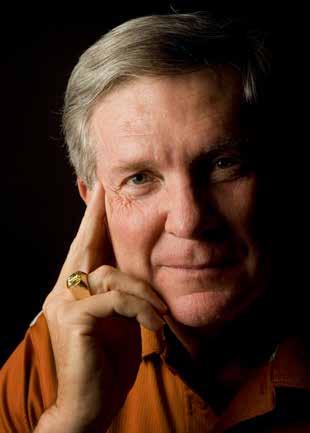
Johnson took the Butkus and Nagurski.
Young was the Rose’s outstanding player, with Dusty Mangum’s last-second field goal giving UT a 38-37 victory over Michigan. On the field, Young promised he’d be back at the Rose next year. He kept his promise.
Brown and fans everywhere always will celebrate Texas’ magical 2005 season. The ever-relaxed Young danced through the year, helping Texas survive Ohio State in September and punctuating the regular season with a 70-3 Big 12 title win over Colorado. Young won the Davey O’Brien Award and was second in the Heisman voting. Safety Michael Huff won UT’s first Thorpe Award.
But there were highs and lows in McCoy’s early years. The Longhorns won 10 games in 2006 and 2007 and posted victories in the Alamo and Holiday bowls. But there were losses to Texas A&M in both years and a defeat by Oklahoma in 2007.
A resurgent Texas turned into Cinderella in 2008. An October upset of Oklahoma sent the Longhorns to No. 1. They maintained that ranking until a last-second loss to Texas Tech in early November. Three teams tied for the South Division lead, but the tiebreaker sent OU to the Big 12 championship. The Longhorns were third in the BCS, so they found solace in beating Ohio State in the Fiesta Bowl for a 12-1 year.
UT won a program-record 13 games in 2009 and secured Brown’s second Big 12 championship. Hunter Lawrence kicked the winning field goal on the game’s final play to beat Nebraska for the conference title and send Texas to the national championship.
“head coach in waiting.”
Instead, Texas cratered in 2010, finishing 5-7 after starting the season ranked in the top five.
How bad was 2010, Brown’s only losing season? Texas lost five games at home, one of them to Iowa State. Gilbert — taking over for the departed McCoy — threw 17 interceptions and only 10 touchdowns.
Brown restructured his staff for 2011, including a new offensive coordinator (Boise State’s Bryan Harsin) and defensive coordinator (Mississippi State’s Manny Diaz). Muschamp had left to become head coach at Florida.
Texas went 8-5 in 2011, beating Cal in the Holiday Bowl. Gilbert lost his starting job early in the second game, a 17-16 win over BYU, and never returned to the lineup for Texas. David Ash and Case McCoy (Colt’s younger brother) quarterbacked the rest of the way.
OPPOSITE: Coach Mack Brown is dunked with water after beating Texas A&M 40-29 at Kyle Field on Nov. 25, 2005. UT players Limas Sweed (4) and Robert Killebrew, right, react.
Then came the national title game. Young dazzled, leading the Longhorns to a 41-38 victory over Southern Cal. The win, the program’s 800th all-time victory, was capped by Young’s fourth-down touchdown run with 19 seconds to go.
Colt McCoy replaced Young in 2006 and carved out his own legacy. His starting record was 45-8, and he broke the national record for most career wins by a quarterback. The two-time Heisman finalist was a double winner of the Walter Camp trophy. McCoy also took home the Maxwell Award in 2009.
But five plays into the game against Alabama, McCoy hurt his neck and shoulder and couldn’t return. Freshman Garrett Gilbert replaced him, and the Longhorns couldn’t generate a consistent offense in a 37-21 loss.
2010–13: The final four 30-20, 2-0 in bowls
What might have changed had McCoy not gotten hurt against Alabama?
Maybe Texas would’ve won Brown’s second national championship. Maybe Brown, who was 58, would’ve retired on top, handing the program over to defensive coordinator Will Muschamp, Texas’
The Longhorns were one game better in 2012, finishing a 9-4 season with a win over Oregon State in the Alamo Bowl. But by then, some fans already were calling for the end of Brown’s tenure after a 63-21 pounding by Oklahoma and a 42-24 loss at Kansas State in the regular-season finale.
Before this season, Brown suggested Texas was about ready to return to national prominence. Then the Longhorns started 1-2, Brown fired Diaz and replaced him with former Longhorns defensive coordinator Greg Robinson, and the team suffered a handful of injuries to starters.
In Brown’s final season, the defense improved, but the record did not. The Longhorns are 8-4 and looking for a new coach.
8 • TEXAS FIGHT
ABOVE: University of Texas head football coach Mack Brown photographed on Aug. 5, 2007.
JAY JANNER / AUSTIN AMERICAN-STATESMAN
JAY JANNER / AUSTIN AMERICAN-STATESMAN
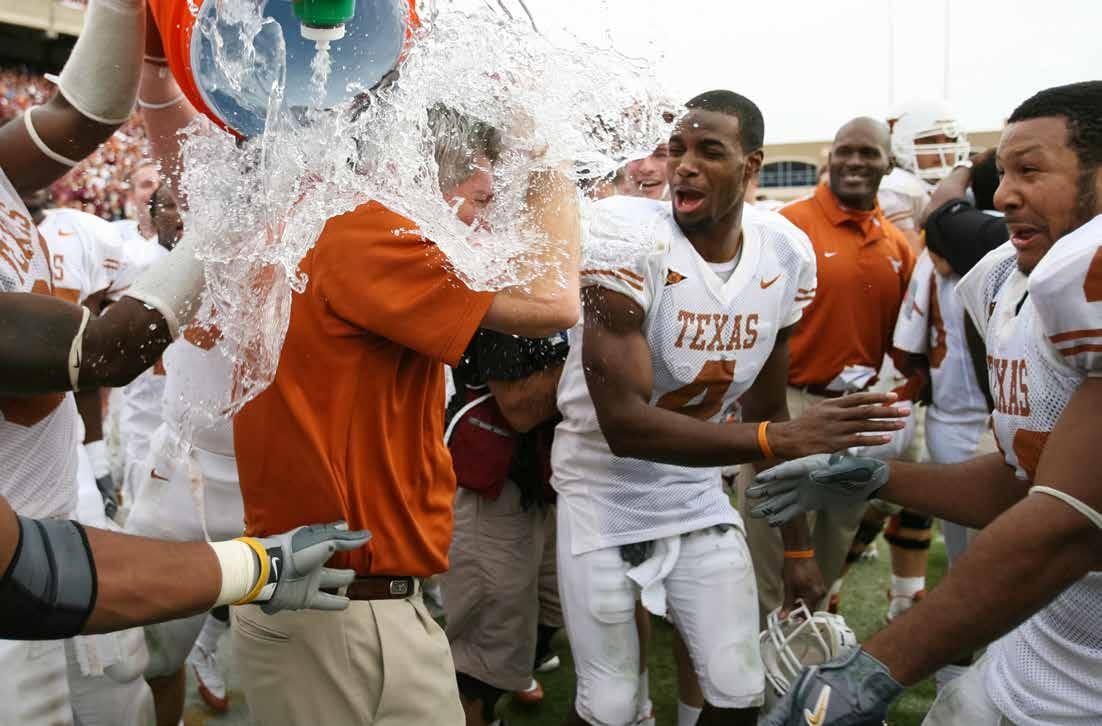
TEXAS’ DEFINING FACES • 9
THE 10 BIGGEST GAMES
The coach’s game
Texas 45 vs. Oklahoma 12
Mack Brown would not be talked into it. Try though they might, the Longhorns couldn’t persuade their head coach to grab the heavy Golden Hat trophy and hoist it on top of his head. The No. 2 Longhorns (5-0) capped their best start since 2002 with a thorough pasting of the unranked and stumbling Sooners (2-3) in the 100th edition of the Red River Rivalry series. The Longhorns started the scoring on an opening, 82-yard drive that culminated in a 15-yard pass from quarterback Vince Young to running back Ramonce Taylor. They got to 45 when defensive tackle Rod Wright scooped up a fumble by OU quarterback Rhett Bomar and lumbered 67 yards to the end zone. Brown outcoached the previously un-outcoachable Bob Stoops. And Mack didn’t gloat. He deflects all the credit to his players and earns their unceasing loyalty. “We did it for Mack,” Texas linebacker Robert Killebrew screamed on the field.
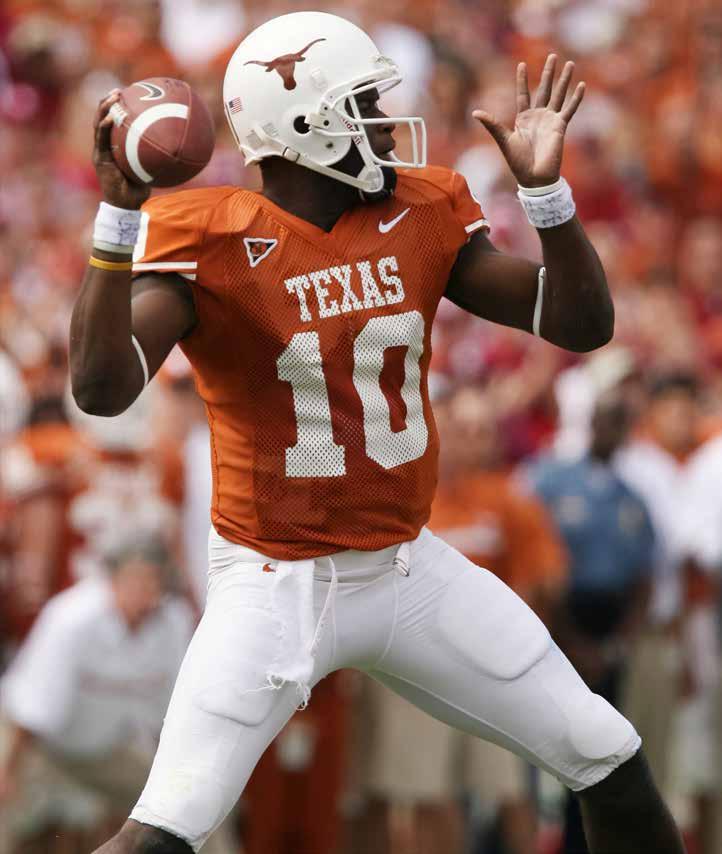
18 • TEXAS FIGHT OCT. 8, 2005

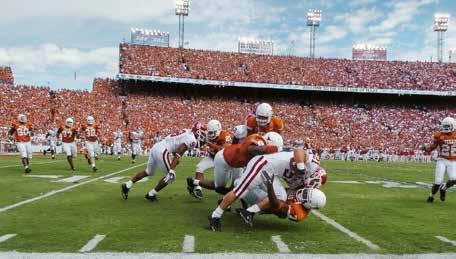
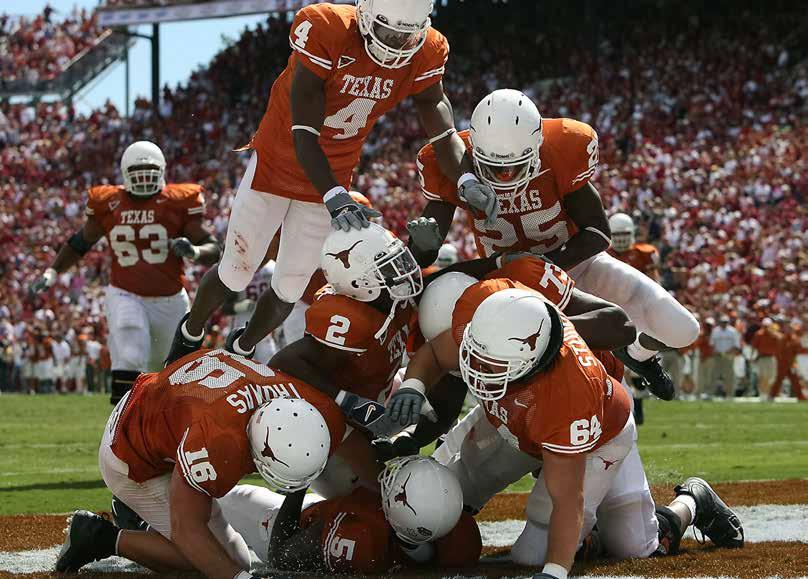
#10
ABOVE LEFT: Texas defenders Michael Huff (7) and Aaron Harris (2) take down Oklahoma running back Jacob Gutierrez (21) near the sideline during first-half action at the Cotton Bowl in Dallas on Oct. 8, 2005.
RODOLFO GONZALEZ / AUSTIN AMERICAN-STATESMAN
ABOVE FAR LEFT: Texas running back Jamaal Charles (25) tries to get past Oklahoma defenders (top to bottom) Nic Harris (5), C.J. Ah You (99) and Dusty Dvoracek (94) in the third quarter on Oct. 8, 2005. JAY JANNER / AUSTIN AMERICAN-STATESMAN
OPPOSITE: Texas quarterback Vince Young makes a completion to Brian Carter in the first quarter of the Red River Rivalry game on Oct. 8, 2005.
JAY JANNER / AUSTIN AMERICAN-STATESMAN
LEFT: Texas teammates celebrate a touchdown by Billy Pittman (5) during the second quarter against Oklahoma on Oct. 8, 2005. DEBORAH CANNON / AUSTIN AMERICAN-STATESMAN
THE 10 BIGGEST GAMES • 19
The last straw
Texas 21 @ Kansas 24 (OT)
Kansas kicker Matthew Wyman knocked a field goal to force overtime, then hit a 25-yarder to send the Jayhawks to a 24-21 victory over the Longhorns. The move made coach Charlie Strong’s future look pretty bleak in Texas. The Longhorns were shaky throughout the game, squandered chances down the stretch, then ran through a fumble and failed fourth-down try in the final minutes of regulation that could have put the game away. Texas running back D’Onta Foreman’s performance was a highlight of the day, as Foreman carried a school-record 51 times for 250 yards and two touchdowns, though his two fumbles proved costly in the end.
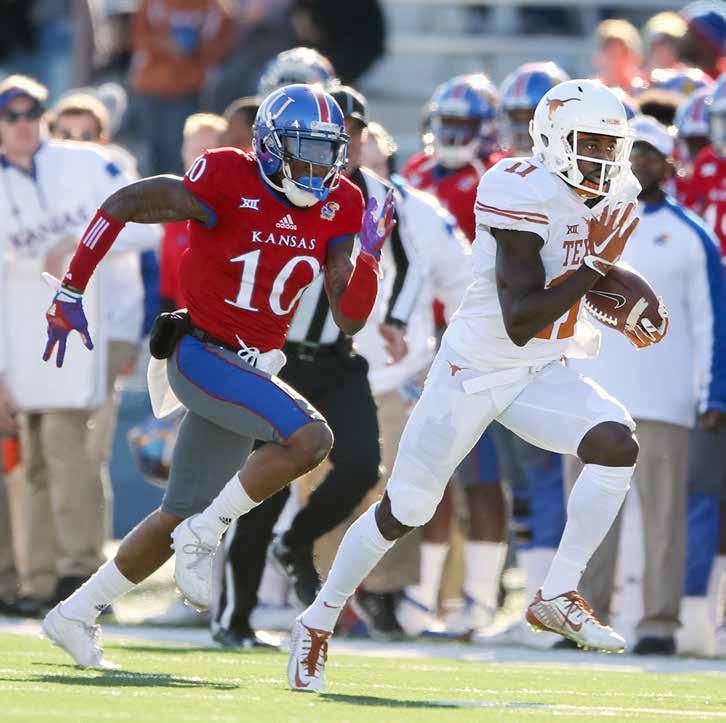
20 • TEXAS FIGHT NOV. 19, 2016
# 9
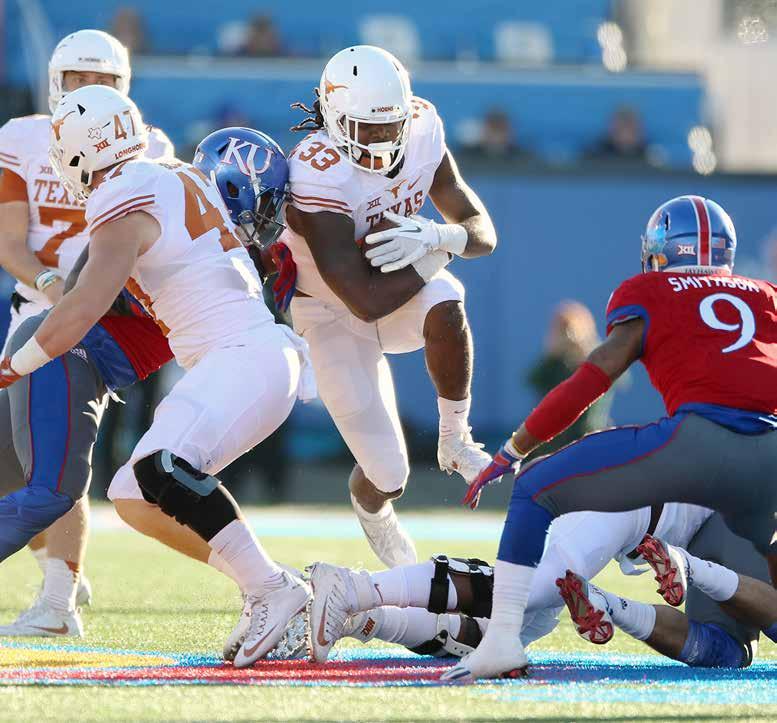
LEFT: Texas running back D’Onta Foreman (33) during the first half in Lawrence, Kan., Nov. 19, 2016. DEBORAH CANNON / AUSTIN AMERICAN-STATESMAN
OPPOSITE: Texas receiver Jacorey Warrick (11) scores on the first play of the game, chased by KU cornerback Marnez Ogletree (10) on Nov. 19, 2016. DEBORAH CANNON / AUSTIN AMERICAN-STATESMAN
THE 10 BIGGEST GAMES • 21
THE 10 BIGGEST PLAYS
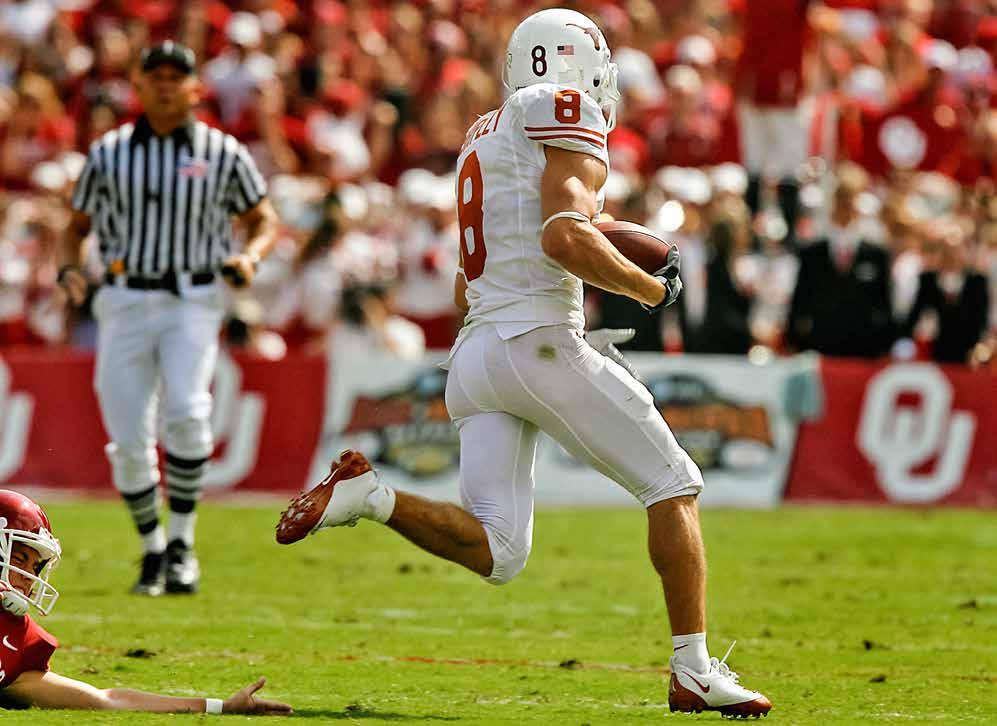
46 • TEXAS FIGHT
Shipley’s kick return sets off huge comeback in historic Red River game
OCT. 11, 2008
In the annual showdown between the 5th-ranked Texas Longhorns and the topranked Oklahoma Sooners, Texas arrived with a quarterback they could rely on and a top-notch defense. Despite trailing for most of the game, Texas quarterback Colt McCoy and his team seized control in the fourth quarter, creating one of the most memorable games in the historic Red River rivalry.
Texas wide receiver Troy Shipley played a pivotal role in the game. He executed a spectacular kickoff return, maneuvering through defenders to reach the end zone. Shipley’s performance was outstanding as he caught 11 passes, the highest number by any player from either team in the 103-game series. Additionally, his 96-yard kickoff return marked the third-longest in Longhorn history and the school’s
longest against the Sooners. McCoy, with 277 passing yards and a touchdown on 28-of-35 attempts, showcased his skills effectively.
Texas faced deficits of 11 points twice in the first half and an eight-point gap in the third quarter. However, they turned the tide by foiling a fake punt and converting it into a go-ahead field goal. This marked the first time all season that the formidable Sooners found themselves trailing. Although Oklahoma briefly regained the lead, McCoy responded with yet another go-ahead score, while the Texas defense prevented Oklahoma quarterback Sam Bradford from mounting a comeback.
A pivotal moment in the game occurred when Texas running back Chris Ogbonnaya turned a seemingly unremarkable play into a 62-yard gain. This
play set the stage for Texas’ most significant victory since their triumph over Southern California in the January 2006 Rose Bowl, much to the delight of their fans in the record crowd of 92,182 at the Cotton Bowl.
Head coach Mack Brown summed up the game’s intensity, stating, “It was a game when every time somebody made a play, the other team would get more excited. It was one of the greatest football games I’ve ever seen.”
McCoy’s leadership was exceptional, completing 28-of-35 passes for 277 yards with a touchdown and no turnovers, despite facing four sacks. He also contributed 31 rushing yards from 14 carries. McCoy remarked, “We were able to attack, able to throw the ball. That was awesome.”
“It was one of the greatest football games I’ve ever seen.”
MACK BROWN
OPPOSITE: Texas receiver Jordan Shipley (8) races towards the end zone on a 95-yard kickoff return past the lunging tackle of Oklahoma’s Matthew Moreland during the second quarter at the Cotton Bowl in Dallas on Oct. 11, 2008. RODOLFO
GONZALEZ / AUSTIN AMERICAN-STATESMAN
THE 10 BIGGEST PLAYS • 47 #10
“It was pretty surreal.”
HUNTER LAWRENCE
Remember Hunter Lawrence’s big kick? He’ll never forget it, either
RYAN AUTULLO • SEPT. 11, 2014
On Saturday, Texas makes its first appearance in Arlington since beating Nebraska five years ago to win the Big 12 title. Hunter Lawrence had hoped to be there, but something came up. So he’ll instead watch from his home in Houston, pulling for the Longhorns to upset No. 12 UCLA in a nationally televised contest at AT&T Stadium.
For those in need of a refresher, Lawrence was the savior of Texas’ 13-12 nailbiter over Nebraska on Dec. 5, 2009. On the verge of burnt orange heartbreak, his 46-yard field goal as time expired sent the Longhorns to the BCS National Championship Game.
“It was pretty surreal,” Lawrence recalled this week.
Little went right that night for Texas, a two-touchdown favorite that was destined for a showdown with top-ranked Alabama for the national title. Nebraska’s defensive wrecking ball Ndamukong Suh lived in Texas’ backfield, sacking Heisman Trophy finalist Colt McCoy 4.5 times. In all, the Huskers sacked McCoy nine times.
With 1:44 to go, Nebraska kicker Alex Henery made his fourth field goal — a 42-yarder — to go ahead 12-10 and bring
hope to fans of TCU and Cincinnati, whose teams also were in play for a championship game berth in Pasadena. Momentum shifted in a hurry. Adi Kunalic’s kick off went out of bounds, and Texas began its final drive from its own 40.
“That’s when I started warming up,” Lawrence recalled.
On first down, McCoy found Jordan Shipley across the middle for 19 yards. A personal foul horse-collar penalty added 15 yards, bringing the Horns to Nebraska’s 26.
Suh sacked McCoy for a 2-yard loss, and McCoy lost another yard on second down. Rather than using its final timeout, the offense strolled leisurely to the line of scrimmage and didn’t snap the ball until there were six seconds left. McCoy rolled right, found no one open, and flung the ball out of bounds on Nebraska’s sideline. The clock read zeros, and Nebraska rejoiced.
An official’s review determined that there was one second left when McCoy’s pass hit the ground.
“On the field, I never thought it was that close,” Lawrence said. “I was under
the impression we had time and we were gonna kick. It looked a lot different on TV, I can tell you that much.”
Nebraska coach Bo Pelini called a timeout to mess with Lawrence, but it didn’t matter, as the senior made his 22nd field goal in 25 tries. As the ball squeezed inside the left upright, Texas’ sideline spilled onto the field. Soon, Lawrence and Shipley, the holder, were at the bottom of a pile of players.
Lawrence became a celebrity on campus. Facebook friend requests came pouring in. Mack Brown sent Texas volleyball coach Jerritt Elliott a No. 15 jersey — not the one Lawrence wore in Arlington, but a Lawrence jersey nonetheless — for inspiration before Elliott’s team played Nebraska in a regional final. Texas won to advance to the Final Four.
Lawrence lasted six months in the NFL before Tampa Bay released him prior to the final preseason game of 2010. He now sells tubing and casing to oil and gas companies. He is engaged to be married and is a regular at Texas home games.
“Looking back, I’m just glad it went in,” Lawrence said. “Life would be a little bit different.”
48 • TEXAS FIGHT
# 9
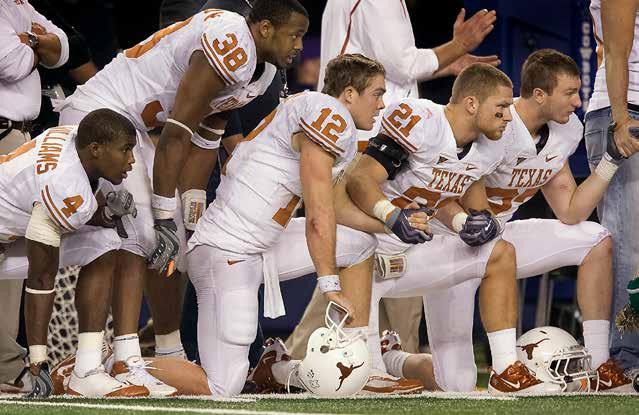
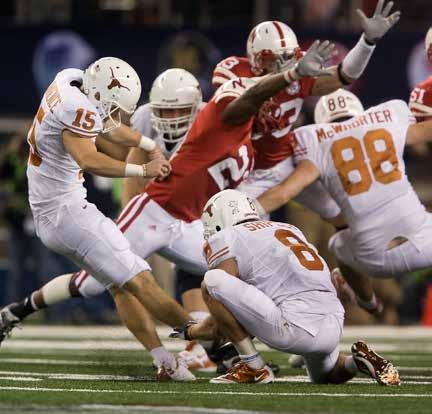
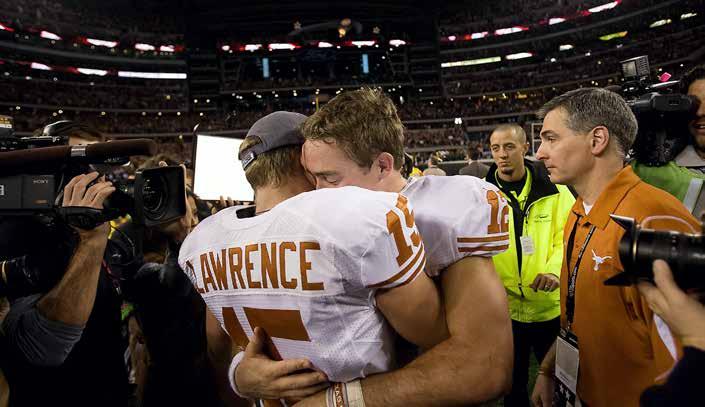
ABOVE: Hunter Lawrence (15) kicks the game-winning field goal as time expires to defeat Nebraska in their Big 12 Championship and berth into the national title game against Alabama. RALPH BARRERA / AUSTIN AMERICAN-STATESMAN
ABOVE LEFT: From left, Aaron Williams (4), Roddrick Muckelroy (38), Colt McCoy (12) and Blake Gideon (21), with other teammates, watch the game-winning kick by Hunter Lawrence that secured victory RALPH BARRERA / AUSTIN AMERICAN-STATESMAN
LEFT: Quarterback Colt McCoy (12) congratulates Hunter Lawrence (15) after he connected on the game-winning field goal with no time left to defeat Nebraska 13-12.
THE 10 BIGGEST PLAYS • 49
RALPH BARRERA / AUSTIN AMERICAN-STATESMAN
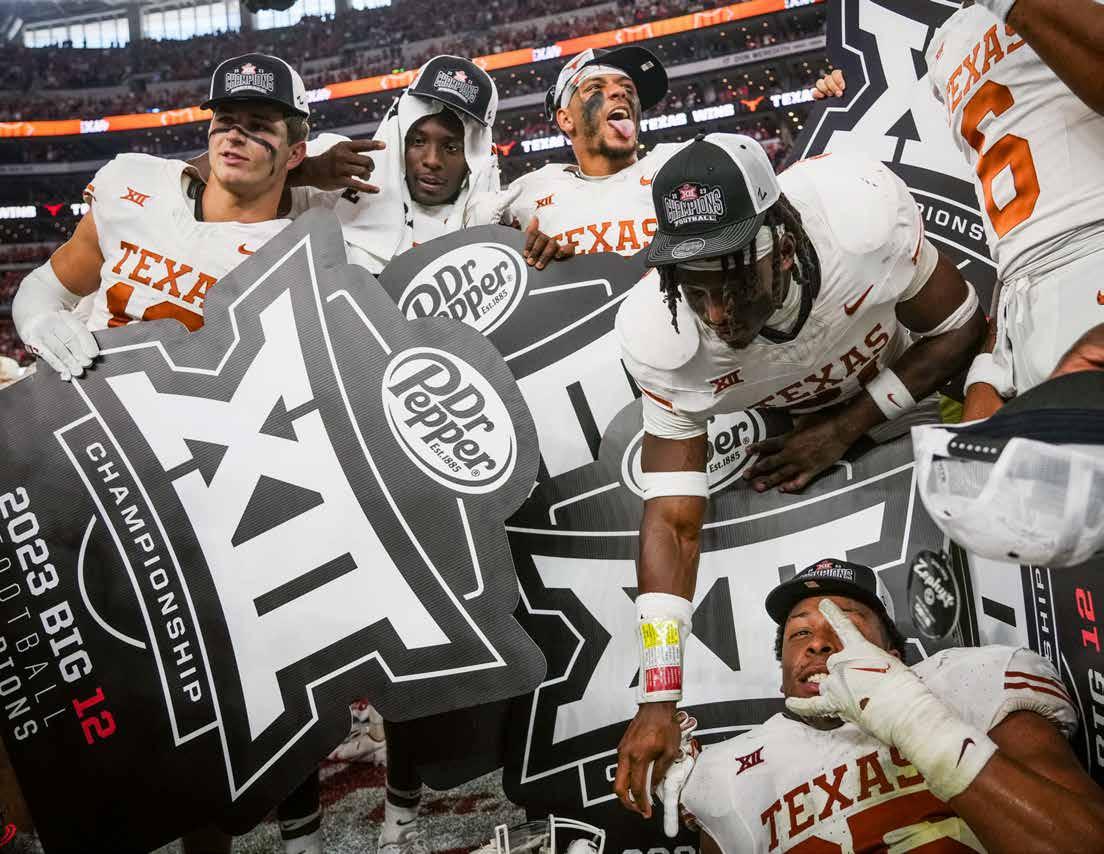

BIG 12 CHAMPIONSHIP GAME
They’re baaack: Texas pounds Oklahoma State for Big 12 title, makes its case for CFP bid
DANNY
DAVIS • DEC. 2, 2023
Texas 49 vs. Oklahoma State 21
ARLINGTON — This spring, Texas football coach Steve Sarkisian taught a history lesson while speaking at a Houston luncheon.
While broaching the subject of UT’s impending move to the Southeastern Conference, Sarkisian assured the fans in attendance that the Longhorns were more focused on the present than the future. He then noted that Texas had left a conference before and added that when UT exited the Southwest Conference after the 1995 season, its final act included a conference championship.
Nearly eight months after that Sarkisian speech, history repeated itself on Saturday.
The SEC-bound Longhorns ended their 27-year run in the Big 12 with a 49-21 win over No. 18 Oklahoma State in the conference championship game at AT&T Stadium. A founding member of the Big
12, Texas won the Big 12’s first championship in 1996 and was crowned again in 2005 and 2009.
In addition to reestablishing itself as the Big 12’s best for the first time in 14 years, Saturday’s victory also kept Texas in contention for a spot in the College Football Playoff. Texas (12-1) will find out if it’s among the four semifinalists on Sunday.
“We talked about making history, being legendary, and made that come to fruition,” wide receiver Jordan Whittington said. “We spoke it into existence.”
Texas scored a touchdown on each of its first four possessions as Ewers threw three touchdown passes. His first was a run-of-the-mill 10-yard toss to receiver Adonai Mitchell, who has now scored 10 times this season.
Then Texas pulled out the razzle dazzle. Facing a third down at the Oklahoma
State 24, Texas ran a reverse as Ewers handed the football off to CJ Baxter, who then pitched it to Mitchell. Mitchell then pitched the ball back to Ewers, who found a wide-open Ja’Tavion Sanders downfield for an easy score.
On its next drive, Texas marched down to the Oklahoma State 2. With UT’s jumbo package on the field, Ewers turned a play-action pass into a touchdown toss to T’Vondre Sweat, the team’s 362-pound defensive tackle and the Big 12 Defensive Player of the Year. To celebrate the score, Sweat struck the Heisman pose.
Earlier in the week, a reporter had reminded Sweat that fellow defensive lineman Byron Murphy II had caught a touchdown pass this season and asked whether he felt Sarkisian needed to dial something up for him.
“Yeah,” Sweat replied.
BIG 12 CHAMPIONSHIP GAME • 151
OPPOSITE: Texas players celebrate after winning the Big 12 Conference Championship Game 49-21 over Oklahoma State at AT&T Stadium in Arlington, Texas, Dec. 2, 2023 SARA DIGGINS / AUSTIN AMERICAN-STATESMAN
/ AUSTIN AMERICAN-STATESMAN
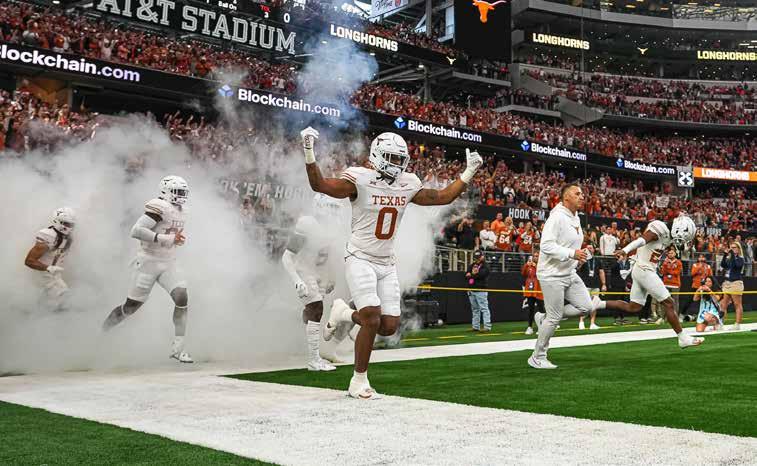
Texas led 21-7 after Sweat scored and that lead swelled to 21 points on Baxter’s 10-yard run with 11:40 left in the second quarter. Oklahoma State (9-4) never got any closer than 14 points the rest of the day.
Texas entered halftime with a 35-14 lead. By that time, Ewers had already thrown for 354 yards and four touchdowns on 23-of-31 passing. Ahead of this weekend, the passing yardage record for the Big 12 championship game was Sam Bradford’s 384 against Missouri in 2008. No title
game participant had ever exceeded the four touchdown passes thrown by Kansas State’s Ell Roberson in 2003 and Oklahoma’s Baker Mayfield in 2017.
Ewers finished the game with 452 passing yards. That was the third-best total in school history.
“I feel like he was in a zone today,” Whittington said. “He was unstoppable.”
After Keilan Robinson ran for two second-half touchdowns, Texas put an exclamation point on its day. Fan favorite Arch Manning took the snap for the
kneel down. Star running back Jonathon Brooks, who tore the anterior cruciate ligament in his right knee, was able to be on the field for that last play.
During the postgame ceremony, Ewers was handed a championship belt by wrestling superstar and noted Texas fan The Undertaker. The Texas fans among a record-crowd of 84,523 then loudly booed Big 12 Commissioner Brett Yormark as he attempted to hand the championship trophy to Sarkisian. Yormark drew the ire of UT fans this summer when he was seen
152 • TEXAS FIGHT
final
RIGHT: Texas wide receiver Ja’Tavion Sanders (0) leads the team out of the tunnel for the Big 12 Championship Game. AARON E. MARTINEZ
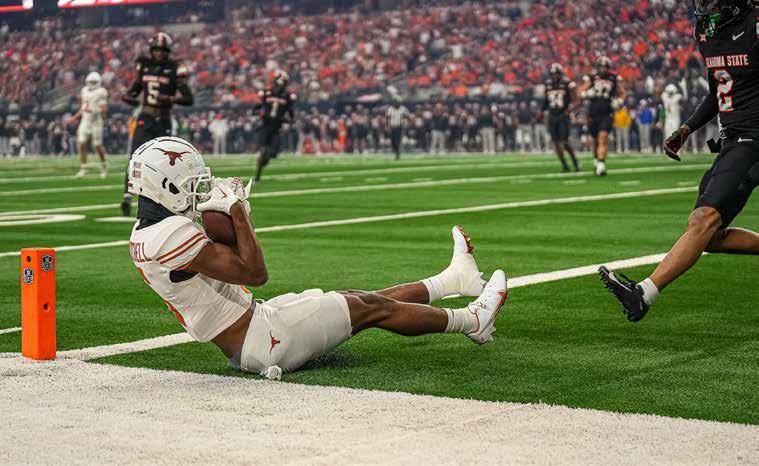
urging Texas Tech coach Joey McGuire to beat the Longhorns.
Then came the confetti.
Texas now must wait to see if its blowout victory convinced enough members of the College Football Playoff committee that the Longhorns belong in that postseason competition. Texas entered the day knowing that No. 5 Oregon (11-2) had lost to No. 3 Washington (13-0) in the Pac-12 finale and that No. 6 Ohio State (11-1) didn’t reach a conference championship contest. No. 1 Georgia (12-0), No.
2 Michigan (12-0) and No. 4 Florida State (12-0) still had to play on Saturday when Sarkisian was asked in a postgame press conference to campaign for his team.
“This may be a little bullish of me saying, but we’ll play anybody in the country. I’m not shying away from that part,” Sarkisian said. “I feel very comfortable, if we get into this tournament, we’ll play anybody. We’ll find out if we’re good enough or not. But I feel like we have the team, the culture, the scheme and the versatility of this team to play against anybody.”
In the immediate aftermath of the game, Sarkisian said he hadn’t planned a watch party yet for Sunday’s announcement. But regardless of whether Texas makes the playoff or not, the coach said that he’ll consider this season to be a success.
“Without question. This season has been an amazing success and we’re not done regardless, we’re not done,” Sarkisian said. “We went into the season to be champions and we are. These guys are wearing hats that says ‘Champions’ across the top and that says a lot.”
BIG 12 CHAMPIONSHIP GAME • 153
LEFT: Texas wide receiver Adonai Mitchell (5) catches a touchdown pass during the Big 12 Championship Game. AARON E. MARTINEZ / AUSTIN AMERICAN-STATESMAN



















